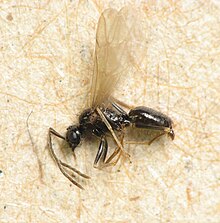en
names in breadcrumbs


Taxonomic history
Wheeler, 1930c PDF: 16 (w.); Wheeler & Wheeler, 1953c PDF: 142 (l.); Hauschteck, 1962 PDF: 219 (k.); Williams & LaPolla, 2016 10.11646/zootaxa.4200.2.1 PDF: (w.q.m.).Combination in Prenolepis: Mayr, 1886d PDF: 431.Senior synonym of Prenolepis nitens americana: Emery, 1893k PDF: 635; Dalla Torre, 1893 PDF: 178.Senior synonym of Prenolepis wichita: Dalla Torre, 1893 PDF: 178; Wheeler, 1930c PDF: 15.Senior synonym of Prenolepis imparis minuta: Creighton, 1950a PDF: 414.Senior synonym of Prenolepis imparis pumila: Creighton, 1950a PDF: 414.Senior synonym of Prenolepis imparis testacea: Creighton, 1950a PDF: 414.Senior synonym of Prenolepis imparis californica: Wheeler & Wheeler, 1986g PDF: 14.Senior synonym of Prenolepis imparis arizonica: Williams & LaPolla, 2016 10.11646/zootaxa.4200.2.1 PDF: 223.Senior synonym of Prenolepis imparis colimana: Williams & LaPolla, 2016 10.11646/zootaxa.4200.2.1 PDF: 223.Senior synonym of Prenolepis imparis coloradensis: Williams & LaPolla, 2016 10.11646/zootaxa.4200.2.1 PDF: 223.Senior synonym of Prenolepis imparis veracruzensis: Williams & LaPolla, 2016 10.11646/zootaxa.4200.2.1 PDF: 223.See also: Wheeler, 1930c PDF: 16.
Prenolepis imparis, commonly known as the winter ant, false honey ant, or false honeypot ant, is a species of ant in the genus Prenolepis.[1] The species is found in North America, from Canada to Mexico, nesting deep within the ground. Unusual among ants, Prenolepis imparis prefers lower temperatures, including near freezing, and is only active outside the nest during winter and early spring.[2] Prenolepis imparis enters a hibernation-like state called aestivation during the summer.
P. imparis secretes an opaque white liquid from its abdomen as a defense against other ants, including Linepithema humile.[3] The defensive secretions appear to be derived anatomically from the Dufour's gland and has been shown to contain a mixture of alkanes and alkenes including hexadecene, octadecene, tetradecene, octylcyclohexane, and hexadecane.[4] Secretions from P. imparis have experimentally been shown to often kill L. humile workers.[4]
 Prenolepis imparis, male
Prenolepis imparis, male Prenolepis imparis, commonly known as the winter ant, false honey ant, or false honeypot ant, is a species of ant in the genus Prenolepis. The species is found in North America, from Canada to Mexico, nesting deep within the ground. Unusual among ants, Prenolepis imparis prefers lower temperatures, including near freezing, and is only active outside the nest during winter and early spring. Prenolepis imparis enters a hibernation-like state called aestivation during the summer.
P. imparis secretes an opaque white liquid from its abdomen as a defense against other ants, including Linepithema humile. The defensive secretions appear to be derived anatomically from the Dufour's gland and has been shown to contain a mixture of alkanes and alkenes including hexadecene, octadecene, tetradecene, octylcyclohexane, and hexadecane. Secretions from P. imparis have experimentally been shown to often kill L. humile workers.